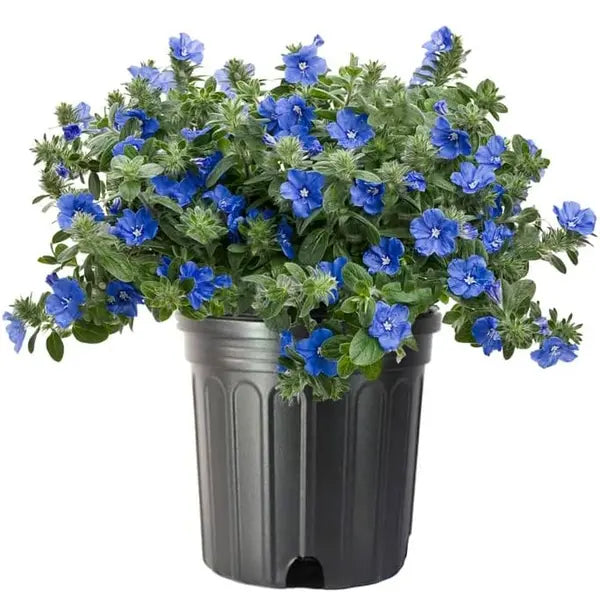Blue Daze, Evolvulus glomeratus, Dwarf Morning Glory
- Rs. 149.00
-
Regular price
Rs. 465.00 -
-67%
- Will be in stock after
Vendor: Jiffy Plants
Couldn't load pickup availability
Spend Rs 1499 for free shipping
Guarantee safe checkout


Blue Daze, Evolvulus glomeratus, Dwarf Morning Glory
Selling size: Single Plant | 2.5" Pot Included | Secure Packing
Disclaimer: It is a sensitive plant that may be damaged during transit if a delay happens and is not recommended for northern, eastern and western India.
Blue Daze (Evolvulus glomeratus), also known as Dwarf Morning Glory, is a charming, low-growing plant prized for its vibrant blue flowers and silvery-green foliage. It's relatively low-maintenance, especially in warm climates, making it a popular choice for ground cover, hanging baskets, and container gardens.
Here's a comprehensive guide to Blue Daze, Evolvulus glomeratus, Dwarf Morning Glory plant care:
1. Sunlight:
Full Sun is Key: Blue Daze thrives in full sun, meaning it needs at least 6-8 hours of direct, unfiltered sunlight daily. This is crucial for abundant flowering and maintaining its compact, bushy form.
Partial Sun Tolerance: While it can tolerate partial sun (some direct sun mixed with shade), extended periods in lower light can lead to leggy growth, fewer blooms, and a duller foliage color.
2. Soil:
Well-Draining is Essential: This is perhaps the most critical factor. Blue Daze absolutely hates soggy soil, which can quickly lead to root rot. Ensure your soil drains exceptionally well.
Soil Type: It's quite adaptable to various soil types, including sandy soils, but prefers a slightly acidic to neutral pH (around 5.5 to 7.0). Loamy soil with good drainage is ideal.
Mulch: A light layer of organic mulch can help regulate soil temperature and retain moisture, but keep it away from the plant's base to prevent excess moisture.
3. Watering:
Consistent Moisture (but not soggy): While young and establishing, water regularly to keep the soil consistently moist.
Drought Tolerant Once Established: Once mature, Blue Daze becomes quite drought-tolerant. Allow the top few inches of soil to dry out completely between waterings.
Avoid Overwatering: Overwatering is a common killer of Blue Daze. Always check the soil moisture before watering.
4. Temperature and Humidity:
Heat Lover: Blue Daze absolutely loves warmth and thrives in hot, humid conditions. It performs best in temperatures above 18?C (65?F).
Frost Sensitivity: It is a tender perennial, hardy in USDA Zones 9-11. In colder zones, it's typically grown as an annual and will not tolerate frost. If you're in a colder climate and want to keep it over winter, you'll need to bring it indoors or take cuttings.
Indoor Growing: If growing indoors, place it near a sunny window and ensure good air circulation.
5. Fertilizing:
Monthly During Growing Season: During spring and summer (the active growing season), feed your Blue Daze monthly with a balanced liquid fertilizer (e.g., 10-10-10) according to the product's instructions.
Slow-Release Option: Alternatively, you can use a slow-release granular fertilizer once or twice a season.
Avoid Excess Nitrogen: Too much nitrogen can promote leafy growth at the expense of flowers. If you notice leggy growth with few blooms, cut back on nitrogen and consider a potassium-based fertilizer to encourage flowering.
No Winter Feeding: Do not fertilize during winter if growing as a perennial in warmer climates.
6. Pruning:
Promote Bushiness: When the plant is young, pinch back the growing tips to encourage branching and a bushier, more compact shape.
Address Legginess: If the plant starts to look scraggly or leggy during the season, a light pruning will stimulate new growth and more blooms. You can cut it back to a desirable size.
Self-Cleaning: Blue Daze is self-cleaning, meaning you don't need to deadhead spent blooms. They typically fall off on their own.
7. Pests and Diseases:
Generally Resistant: Blue Daze is quite resistant to most common pests and diseases.
Root Rot: The main issue to watch out for is fungal problems like root rot, almost always caused by overwatering or poorly draining soil.
Occasional Pests: Occasionally, you might encounter fungus gnats or shore flies, but these are usually minor issues. Neem oil can be used if an infestation occurs.
8. Propagation:
Stem Cuttings: Blue Daze can be easily propagated from semi-hardwood stem cuttings in spring or summer. Take 3-5 inch cuttings, remove lower leaves, dip in rooting hormone (optional), and plant in a well-draining potting mix. Keep moist and in bright, indirect light until roots develop.
Seeds: You can also propagate from seed indoors just before the last frost.
9. Uses in the Garden:
Groundcover: Its low-growing, spreading habit makes it an excellent groundcover, forming a dense mat of foliage.
Containers and Hanging Baskets: Its trailing stems are perfect for cascading over the edges of pots, window boxes, and hanging baskets.
Edging: Great for defining beds and borders.
Pollinator Attractor: Its blue flowers attract butterflies and bees.
Drought-Tolerant Landscaping: A good choice for xeriscaping or areas where water conservation is a priority.
By following these care tips, you can enjoy the beautiful, sky-blue blooms of Blue Daze throughout the warm season!


